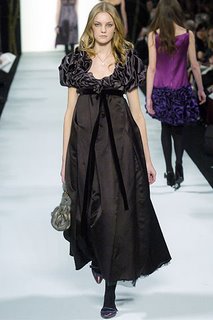Imitation and a Cultural Aesthetic

You make a good point, China; there are certainly cases that art is imitative. I guess that what I resist the idea that it is *always* imitative. That is, there are many times (take Van Gogh's renderings of his Room at Arles) when an artist will paint a craftsman's work but ask us to view it differently. So while it has the capacity to imitate, like you are talking about, it is not in essence imitative, for it will not always do so. It's a fine line.
Also, speaking about culture and art - I think it is really easy to see how our aesthetic sense is culturally conditioned in fashion. I would argue that some of the "high" fashion houses' clothes are art (they are creative, often provocative, often beautiful). Looking at how fashions change from season to season, year to year, and decade to decade can be incredibly revealing. Every ten years or so, there are a couple of collections that re-attune our aesthetic senses; the pattern is clear, as one issue of Vogue pointed out. A controversial new shape enters the fashion realm and people hate it at first. But, as time wears on, they begin to see its beauty and indeed emulate it. Take Marc Jacobs Fall 2005 collection (follow link). Called "lumpenly ugly" and full of "prom dresses for pregnant teenagers," it sold remarkably well and is already rippling through other collections. A collection like this overturns and reconditions our sense of the beautiful.
I just find it really interesting to watch fashion as a cultural register of sorts, because it is so visible and updates itself twice a year. More conventional forms of art take much longer to sort themselves out - books take years to write and more time to publish, paintings must make their ways into galleries and then people have to see them, but fashion is thrown at us in magazines, on tv, and in stores.
